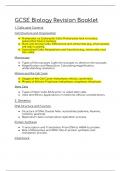GCSE Biology Revision Booklet
1. Cells and Control
Cell Structure and Organisation
● Prokaryotic vs. Eukaryotic Cells: Prokaryotes lack a nucleus,
eukaryotes have a nucleus.
● Plant and Animal Cells: Differences and similarities (e.g., chloroplasts,
cell wall in plants).
● Specialized Cells: Adaptations and functions (e.g., nerve cells, root
hair cells).
Microscopy
● Types of Microscopes: Light microscopes vs. electron microscopes.
● Magnification and Resolution: Calculating magnification,
understanding resolution.
Mitosis and the Cell Cycle
● Stages of the Cell Cycle: Interphase, mitosis, cytokinesis.
● Phases of Mitosis: Prophase, metaphase, anaphase, telophase.
Stem Cells
● Types of Stem Cells: Embryonic vs. adult stem cells.
● Uses and Ethics: Applications in medicine, ethical considerations.
2. Genetics
DNA Structure and Function
● Structure of DNA: Double helix, nucleotides (adenine, thymine,
cytosine, guanine).
● Replication: Semi-conservative replication process.
Protein Synthesis
● Transcription and Translation: From DNA to mRNA to protein.
● Role of Ribosomes and tRNA: Site of protein synthesis and
translation process.
Inheritance
, ● Mendelian Genetics: Dominant and recessive alleles, homozygous
and heterozygous.
● Punnett Squares: Predicting genetic crosses and inheritance
patterns.
● Sex Determination: Role of X and Y chromosomes.
Genetic Disorders
● Types and Examples: Cystic fibrosis, sickle cell anemia, Huntington’s
disease.
● Inheritance Patterns: Autosomal recessive, autosomal dominant, sex-
linked traits.
3. Natural Selection and Genetic Modification
Natural Selection
● Process of Natural Selection: Variation, competition, survival of the
fittest.
● Evolution: How species evolve over time, fossil evidence.
Genetic Modification
● Techniques: Gene cloning, CRISPR.
● Applications: GM crops, gene therapy.
Selective Breeding
● Process and Examples: Breeding plants and animals for desired
traits.
4. Health, Disease, and Medicine
Communicable Diseases
● Pathogens: Bacteria, viruses, fungi, protists.
● Transmission: How diseases spread, examples like malaria, HIV.
Non-Communicable Diseases
● Types: Cancer, heart disease, diabetes.
● Risk Factors: Lifestyle factors, genetic predisposition.
Immune System
● Primary and Secondary Defenses: Physical barriers, white blood
cells, antibodies.
● Vaccination: How vaccines work, herd immunity.




